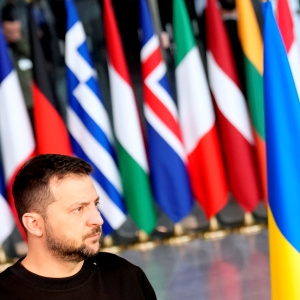Just a big kid at art: Carle Museum showcases children’s book art of legendary graphic designer Seymour Chwast
| Published: 11-29-2023 8:37 PM |
Seymour Chwast turned 92 this summer. But in his heart, he might still be about 8 or 9 years old, based on the work he continues to create.
A legendary graphic designer who, beginning in the 1950s, helped revolutionize the look of commercial art, Chwast has also used his unique style and sensibility to create 40 children’s books, finding both humor and delight in a child’s view of the world.
Yet his work as a children’s book author and illustrator, observers say, has been overshadowed by his graphic design career. So the Eric Carle Museum has set out to rectify that with the first-ever exhibit focused exclusively on Chwast’s picture book art.
“Kid in a Candy Store,” which runs through April 14, features work from a range of Chwast’s books, including illustrations, interactive designs, posters and examples of the unconventional format of some of his work — like 1999’s “Traffic Jam,” which has six large, colorful panels that unfold to show the extent of the roadblock.
“He says he’s always been most interested in ‘books that do things,’” said Ellen Keiter, chief curator at the Carle Museum, during a recent tour of the exhibit. “He’s taken his experience in graphic design and used that to kind of reimagine how books can be presented.”
Other books unfold to become paper animals, or use animals as the basis for examining different shapes. His 2022 book, “Where’s My Cat?’ invites young readers to guess how an ordinary object can be part of and animal by flipping a page. Thus a comb, for example, becomes the torso of a tiger.
The Carle exhibit replicates some of those pages with selected wooden panels on the wall that visitors can manipulate; a few children seemed to delight in doing that during a recent late weekday morning.
Chwast (pronounced Kwahst) has a distinct visual approach to his art as well, Keiter says.
Article continues after...
Yesterday's Most Read Articles
 Political newcomer defeats Shores Ness for Deerfield Selectboard seat
Political newcomer defeats Shores Ness for Deerfield Selectboard seat
 Granby Bow and Gun Club says stray bullets that hit homes in Belchertown did not come from its range
Granby Bow and Gun Club says stray bullets that hit homes in Belchertown did not come from its range
 Annette Pfannebecker: Vote yes for Shores Ness and for Deerfield
Annette Pfannebecker: Vote yes for Shores Ness and for Deerfield
 Susan Tracy: Support Ukraine funding
Susan Tracy: Support Ukraine funding
 Around Amherst: Bockelman joins in launch of governor’s housing push
Around Amherst: Bockelman joins in launch of governor’s housing push
 Defying the odds: Hadley’s Owen Earle back competing less than two years removed from horrific accident
Defying the odds: Hadley’s Owen Earle back competing less than two years removed from horrific accident
“He uses really bright colors and flat drawings to add to the sense of fun. There’s no sense of depth to his art. He wants it to be immediate, something kids can relate to … and he brings that love for typography in his commercial art” to his books, Keiter explains.
Chwast, a lifetime New Yorker, was born in the Bronx in 1931 and showed an early affinity for art. He graduated from Cooper Union, the free New York College of art, in 1951, and worked briefly for the New York Times in the paper’s promotion department before co-founding a leading graphics company, Push Pin Designs, in 1954.
Leonard S. Marcus, a preeminent writer about children’s books and their creators, notes in an essay about “Kid in a Candy Store” that Push Pin soon went on to change the look of illustration art “across all media” — and that one historian of Chwast’s design group called them “the Beatles of illustration and design.”
Keiter says it was Marcus — he is a founding trustee of the Carle Museum — who proposed hosting an exhibit on Chwast’s children’s book art: “He felt it was long overdue, that Seymour has never gotten as much credit as he deserves for that part of his career.”
Chwast was game and came to the Carle with Marcus earlier this year to discuss with Keiter how to put the show together (Marcus curated the exhibit). Chwast had some specific ideas, such as mounting wires overhead on which museum staff could mount his flat, hand-painted birds on paper; they have the homespun look of art created by kids.
The exhibit’s title also speaks to Chwast’s whimsical ideas and sensibility. Marcus, in his essay, notes that Chwast, asked at one time what he would have done if he hadn’t had a career in graphic art, said “I would have opened a candy store.”
Marcus says Chwast’s work in commercial design was also charged by a sense of fun, in that he and his colleagues at Push Pin Designs wanted to break away from the Modernist aesthetic that dominated graphic design of that era, which despite its clean lines “could also feel quite chilly.”
Chwast, who as a student “had fallen in love” with a range of past design styles, and his Push Pin colleagues “came to the same exhilarating conclusion,” Marcus writes. “Why toss out the past when you can have fun playing with it instead?”
“Push Pin became known for its deft, eclectic, hipster brand of ‘illustrative design,’ and Chwast himself for the buoyant wit and offhand grace with which he gave art nouveau, art deco, and other vintage styles a contemporary, youth culture makeover in posters, typefaces, and myriad other projects.”
In 1967, Chwast also illustrated his first children’s book, “Sara’s Granny and the Groodle” by Joan Gill, and he’s been illustrating and designing children’s books ever since.
The artist draws on his childhood in New York in the 1930s and 1940s for the background to his illustrations in works such as “Moonride,” in which a friendly moon with eyes, nose and mouth comes into a boy’s bedroom to offer him a nighttime jaunt above the city. They also visit a bakery where cookies have just come out of an oven.
Another story, 1991’s “The Alphabet Parade,” features crowds of people — including the occasional monster and witch — watching a passing festival with floats and marchers that highlight each letter, such as a group of bears and a man on a bicycle for the letter “B.”
Keiter says Chwast also has his serious side. He designed a number of antiwar posters during the Vietnam War, she notes, and several years ago he published “At War with War,” a collection of stark pen-and-ink drawings and woodcuts illustrating history’s most notorious battles, going back 5,000 years.
That kind of somber art is not part of the Carle exhibit, but a few samples of his commercial designs are, including a poster he designed over 40 years ago for the Brooklyn Children’s Museum — still displayed there today, Keiter says.
“The range of his work is just amazing,” she said.
Visitors can check also out a number of Chwast’s books at the exhibit, including one that might be the best example of his playful style: “Tall City, Wide Country,” a tale of two rural children who travel to a city. The book is read horizontally to begin with, then becomes a vertical read when the kids reach the soaring dimensions of the city.
Marcus notes that Chwast once described himself as “a commercial artist [who] always wanted to do books.” Now, six decades later, Marcus writes, “he is a book artist who also does commercial art, creating book after book, each one a surprise that is worth the wait.”
Seymour Chwast and Leonard Marcus will host a conversation about the artist’s work on Dec. 16 from 1 to 2 p.m. at the Eric Carle Museum. A book signing will follow.
Steve Pfarrer can be reached at spfarrer@gazettenet.com.















 A DIY approach to flying: Local pilots build and help build their own aircraft
A DIY approach to flying: Local pilots build and help build their own aircraft You’re up next: Western Mass open mic scene heats up post-pandemic
You’re up next: Western Mass open mic scene heats up post-pandemic One upon a story slam: This year’s Valley Voices winners head to a final competition
One upon a story slam: This year’s Valley Voices winners head to a final competition Preserving a key part of Emily Dickinson’s legacy: Historic Evergreens house reopens at the Emily Dickinson Museum
Preserving a key part of Emily Dickinson’s legacy: Historic Evergreens house reopens at the Emily Dickinson Museum